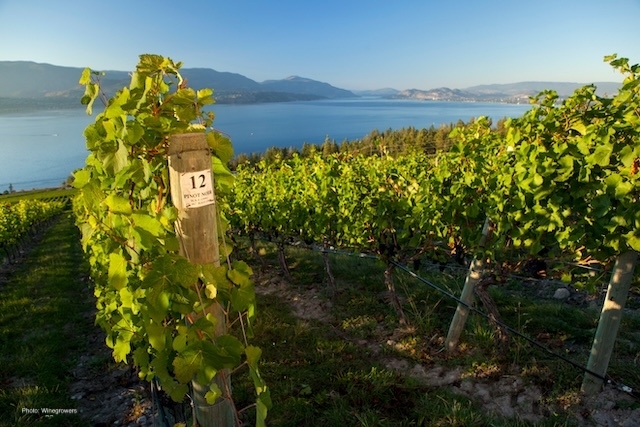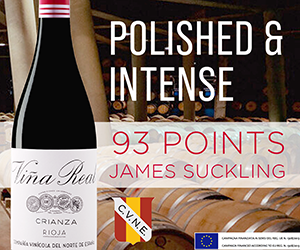In our ongoing series on British Columbian pinot noir, Kelowna is the focus this month, and its two sub-gis, both located on the eastern side of Okanagan Lake, East Kelowna Slopes and South Kelowna Slopes.
Separated from the Southwest corner of East Kelowna Slopes sub-GI by only a 1.5 km isthmus of urban development, the South Kelowna Slopes sub-GI differs substantially because its 800 hectares run in a narrow strip along the shore of Okanagan Lake from Upper Mission to Okanagan Mountain Park. Its landward border follows the contour of residential development along half its length, and there are even some residential pockets within its boundaries.

Similarly to East Kelowna Slopes, the glacial forces from the most recent Ice Age that occurred approximately 12,000 years ago formed the current surface soil materials of South Kelowna Slopes, where sediments and soils were deposited through glacial ice contact, movement and related meltwater. Bellevue Creek and other local creeks, originating in the uplands to the East of the GI, deposited sand and gravel, creating a series of fans and terraces. Modern day creeks have cut through glacial deposits creating gullies and escarpment slopes. Fans have formed below 360m where Bellevue, Lebanon and Bertram Creeks meet Okanagan Lake.
As with other sub-GIs, the South Kelowna Slopes boundaries utilize natural features. The shore of Lake Okanagan defines the Northern portion while various other natural and urban features set the Southern boundary. The northeast corner of South Kelowna Slopes is a mixed agricultural “island” with vineyards. It is separated from the rest of the sub-GI by a residential area. It contains one winery. Okanagan Mountain Park is included within the GI only to accommodate a small parcel of land west of the park with some potential for viticulture. Though some local topographical features rise much higher, the existing wineries which all lie close to the shoreline are at an elevation around 600m.
The moderating effect of Lake Okanagan Lake influences the climate of the South Kelowna Slopes GI. This influence impacts the growing season climate in two ways: temperatures are moderated to be slightly cooler in the day and slightly warmer at night, and the length of the growing season is increased due to the reduced risk of frost in late Spring and early Fall. This creates a long, cool growing season, favourable to pinot noir, which accounts for most of the red wine grape acreage. The growing degree days, depending on location in the sub-GI, can range from 1200 to almost 1500. The frost-free period is about 210 days.
There are approximately 120 ha of vineyards in South Kelowna Slopes, with Pinot Noir occupying 33 hectares out of 45 hectares dedicated to red grapes.
The soils here are mostly gravelly loamy sands, and their coarse texture and low water holding capacity enable reasonable control of vine vigour and fruit yield. This allows for fine adjustment of fruit ripening and the timing of maturation. The wineries in this sub-GI include CedarCreek Estate Winery, St. Hubertus & Oak Bay Estate Winery, Scorched Earth Winery, Summerhill Pyramid Winery and Martin’s Lane Winery.
The two most noteworthy pinot noir-producing wineries in this sub-GI:
Martin’s Lane Winery
Mission Hill’s Anthony von Mandl launched the Martin’s Lane label in 2009 to honour his father, Martin, who died in 1994. The winery focuses on wines made from pinot noir and riesling. It makes a range of estate and single-vineyard pinot noirs from a variety of sites in the Okanagan. The only one on the home property in South Kelowna, however, is the Simes Vineyard. Originally called the Lakeshore Vineyard, it was renamed to honour John Simes, the long-time, now retired, Mission Hill winemaker.
The emphasis on pinot noir at Martin’s Lane proved early when, in 2013, its 2011 was named the “World’s Best Pinot Noir” in the under £15 category at the Decanter World Wine Awards. The winery itself was begun in 2014, located next toCedarCreek Estate Winery, which had been acquired by Mission Hill in the same year. Martin’s Lane Winery opened in 2017.
The current winemaker, Shane Munn, arrived at Martin’s Lane before harvest in 2014. A New Zealand native, he completed a winemaking degree there and coincidentally met the winemaker Darryl Brooker, who later became the winemaker at Mission Hill. Over the next decade or so, he did winemaking stints in Ontario and New Zealand before being hired to helm the winemaking at Martin’s Lane.
The North-facing Simes Vineyard in South Kelowna Slopes was planted in pinot noir in 2008 with clones 943, 667, 777, 114, 115, 828 and Swan. The pinot noir from Simes Vineyard is an exquisite expression of the grape, and they also produce a Simes Vineyard single-block wine called Transcendence.
Cedar Creek Winery
CedarCreek is one of the eight original BC wineries, launched as Uniacke Wines in 1980 by David Mitchel. In 1986, Ross Fitzpatrick purchased the winery and renamed it CedarCreek. It changed hands once more in 2014 when Mission Hill’s Anthony von Mandl purchased it.
CedarCreek’s 50-acre estate vineyard in the South Kelowna Slopes has proved to be an outstanding terroir for Pinot Noir and has steadily evolved its pinot noir program since its first pinot noir release in 1994. The winery currently makes a range of pinot noirs from various sites in the Okanagan Valley. Still, their reputation for pinot noir was firmly established with the wines from their home vineyard.
The distinctiveness of the home block wines emerged over time as the vineyards aged and select blocks demonstrated a capacity for premium quality. Originally released as three tiers of pinot noir from multiple properties, they subsequently made a “Platinum Home Block” bottling.
Later, grapes from two different blocks within the home vineyard produced wines that showed characteristics of terroir that were both different and excellent. Both pinots are made predominantly from clone 115. The vines of Block 2 sit predominantly in clay soils on the lower slopes, and Block 4 vines reside in sandy loam soils on the upper slopes of the same vineyard. These were eventually released separately as Block 2 and 4 (now known as Aspect Block 2 and 4). Among the best pinot noir wines in the province, they have grown more distinctive and elaborated over time.
Head Winemaker for Cedar Creek since 2016, Taylor Whelan, was born and raised in Campbell River on Vancouver Island. After completing a post-graduate diploma in Oenology and Viticulture from Brock University in Ontario, Whelan worked in Niagara, Ontario, as well as for wineries in Hawkes Bay, New Zealand, McLaren Vale, Australia, and in Piper’s River, Tasmania. His interest in cool climate grape growing and winemaking brought him to CedarCreek for harvest in 2011.
BC Pinot Noir Sub-GI Series
East Kelowna Slopes, Summerland Valleys, Summerland Bench, Summerland Lakefront, Okanagan Falls, Cowichan Valley

 quicksearch
quicksearch






